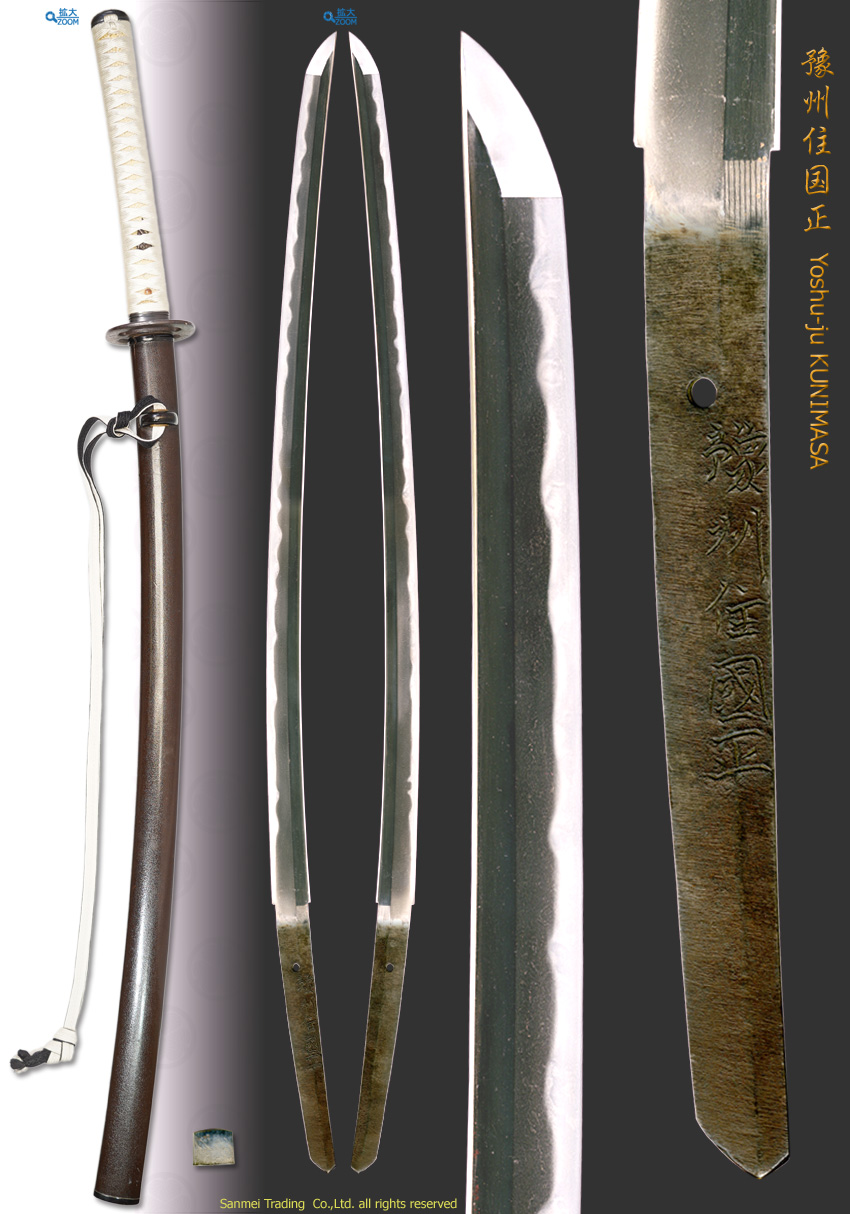with)Blown stone finish lacquered scabbard Kobusho style Uchikatana Koshirae
Length of cutting edge : 75.8cm Curvature : 1.8cm Width of base : 33.1mm Width of Yokote : 22.0mm Thickness of base : 8.0mm
Forging pattern (kitae hada) : Kitae hada is fine Itame with Mokume burl and flowing Masame hada is perceived along Shinogi-ji surface.Crystallized Ji-nie (hard metal granules over the surface) sparkles clearly against thick lines of Chikei (darkish Nie lines) activity.
Tempering pattern (hamon) : Hamon starts with shallow Yakidashi then makes up undulating Notare mixing with Gunome, Togari-ha and combined Gunome in angles that makes up Crab claws outline. Hamon boundary line activates with a bit on stronger side Nie and isolated activities of YUBASHIRI and TOBIYAKI appear here and there. The interior of temper is filled with deep NIOI mist with abundant activities of thick Nie-Ashi and bright dots of YOU. Muneyaki temper appears along back ridge from tip down to Munemachi.
Temper of tip (boshi) : Temper of Boshi forms irregular Gunome blaze up indication then medium circle turns back to connect Muneyaki.
Tang (Nakago) : The original Nakago is slightly curved to form waist point curve. The heel of Nakago was V-shape "kengyo". Yasurime is shallow slanting left (katte-sagari) file marks and the back ridge of Nakago is flat with greatly slanting left "Ō-sujikai" filemarks. One Mekugi-ana peg hole. The inscription signature in front is fine character that starts the place of work Yoshu-ju 豫州住 and smith name KUNIMASA 国正.
The smith KUNIMASA 国正 successive generations in Iyo province (now Ehime pref.), they named themselves NISHIMOTO Ichi'uemon 西本市右衛門 and served for DATE clan 伊達家 in Uwajima castle town 宇和島城下 down to the 8th generations throughout the year of Edo Tokugawa period.
The subject last generation KUNIMASA 国正, upon the orders given by the lord of DATE clan 伊達家, He studied under master SUKEHARU 祐春 in Bizen Osafune then set his atelier in Ainan-town, Minami-uwa-gun 南宇和郡愛南町. The record of his extant works with date of year is Bunkyu 2nd (1862) and Genji 2nd (1865).
Kobusho 講武所 military academy was set up in the final decades of the Edo period in response to Japan's experience of Western military power and Military academy was highly recommended. The heroical Katana so called Kobusho-koshirae 講武所拵 had become into vogue among skillful young Samurais of "Hatamoto" or "Gokenin" class. Tokugawa Shogunate set up an official exercise hall of Kobusho 講武所 in Ansei 3 (1856) to get ready for social movement of Sonnō-Jōi (尊皇攘夷 Revere the emperor, expel the barbarians).
Those young and powerful Samurais preferred an extra long sword set in a showy scabbard with long hilt of Unohana un-dyed silk cord small lozenge wrapped. They wear a sword at their sash in a level at the waist horizontally. The winner in Kobusho match was awarded with the Sageo strap of blue-reversed-white color.
with) Brown stone finish lacquered scabbard Kobusho-style Uchikatana Koshirae (click HERE for entire Koshirae / HERE for each fitting)
- Fuchi/Kashira : Shakudo ground polish surface, unsigned
- Menuki : Shishi lions design, Shakudo ground katabori carving
- Tsuba : Sea cucumber design open work, Iron ground, unsigned
- Tsuka : White rayskin, Uniohana un-dyed silk cord Hiramaki-style lozenge wrap
Recent polish/Condition scale: mint - excellent (using a scale of mint-excellent-very good-good-fair-poor).
reference data : Honma Kunzan / Ishii Masakuni NINONTO MEIKAN Yuzankaku, 1975



